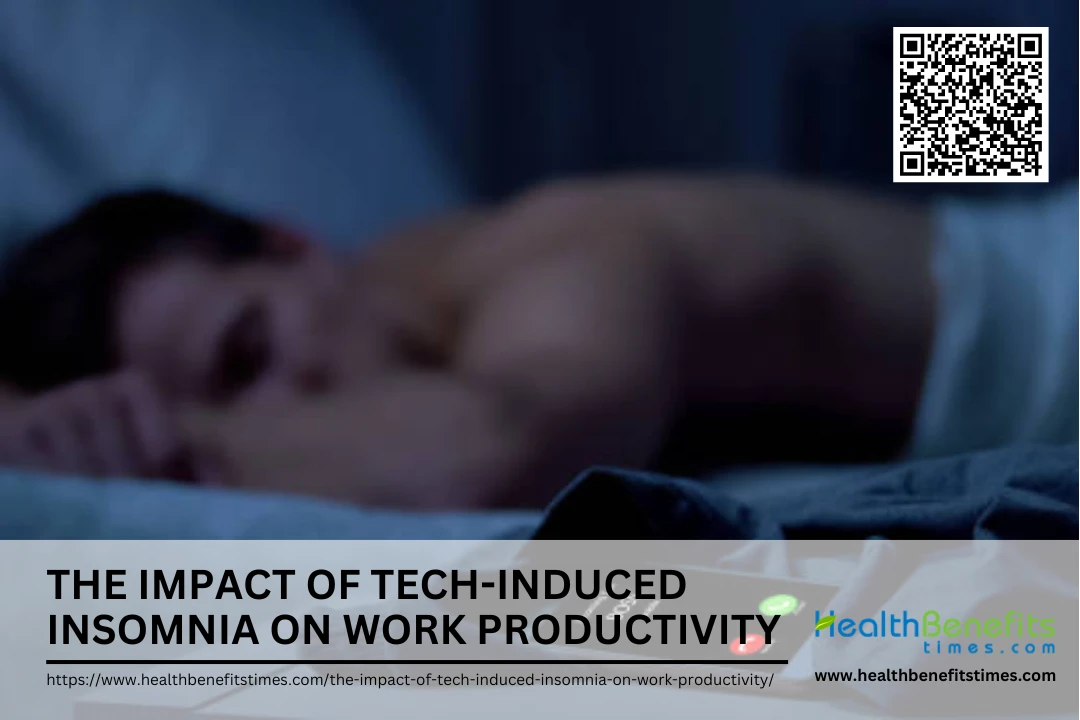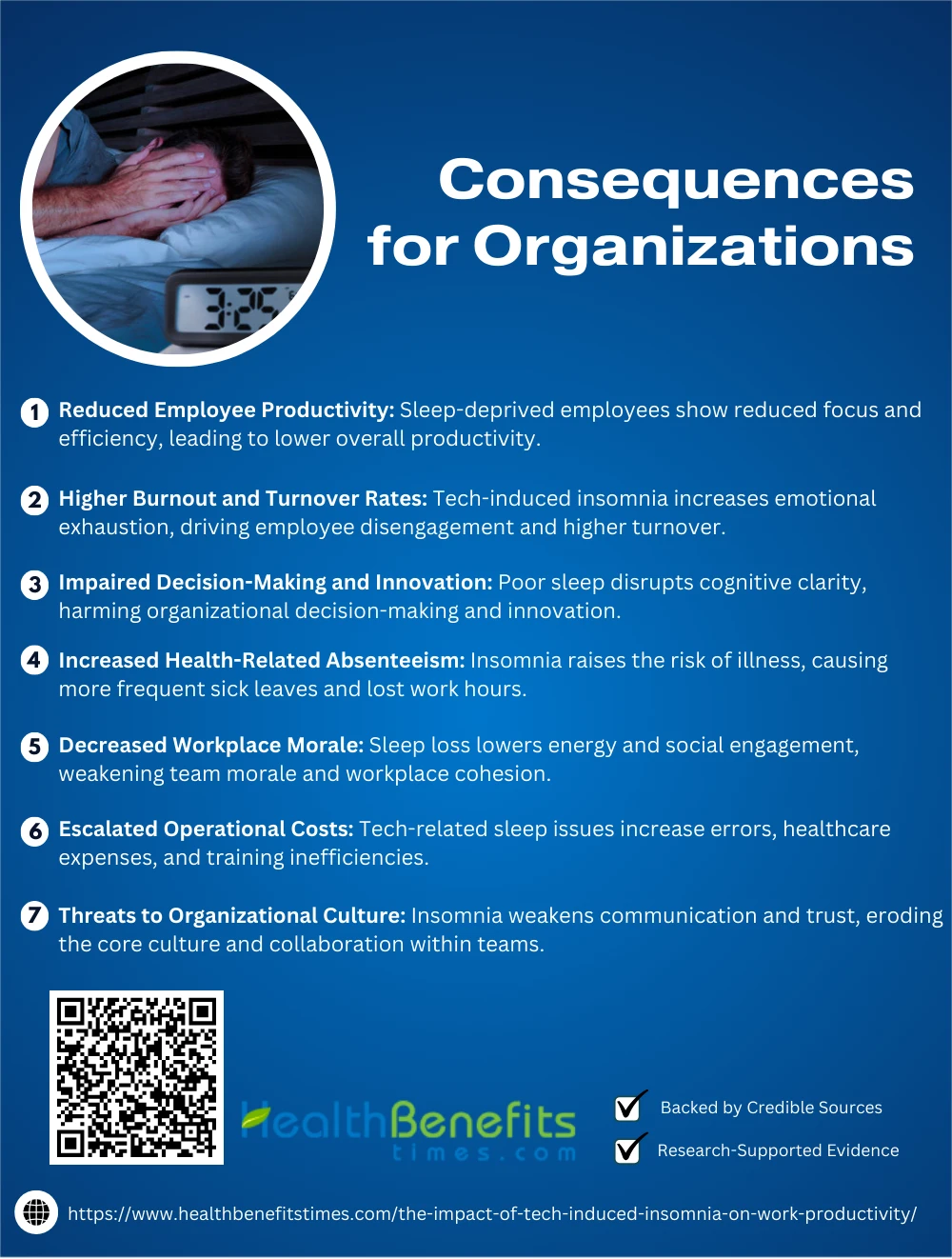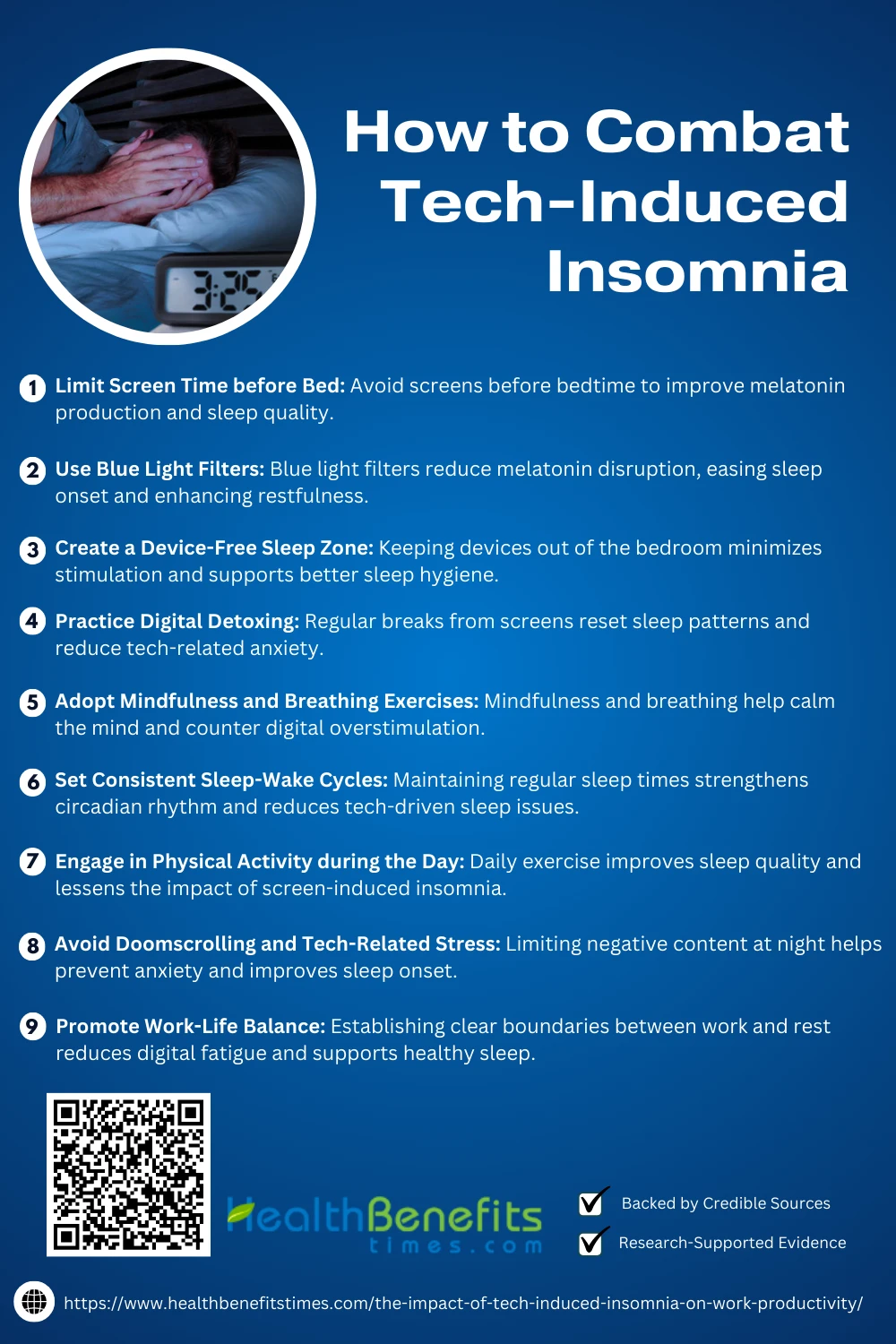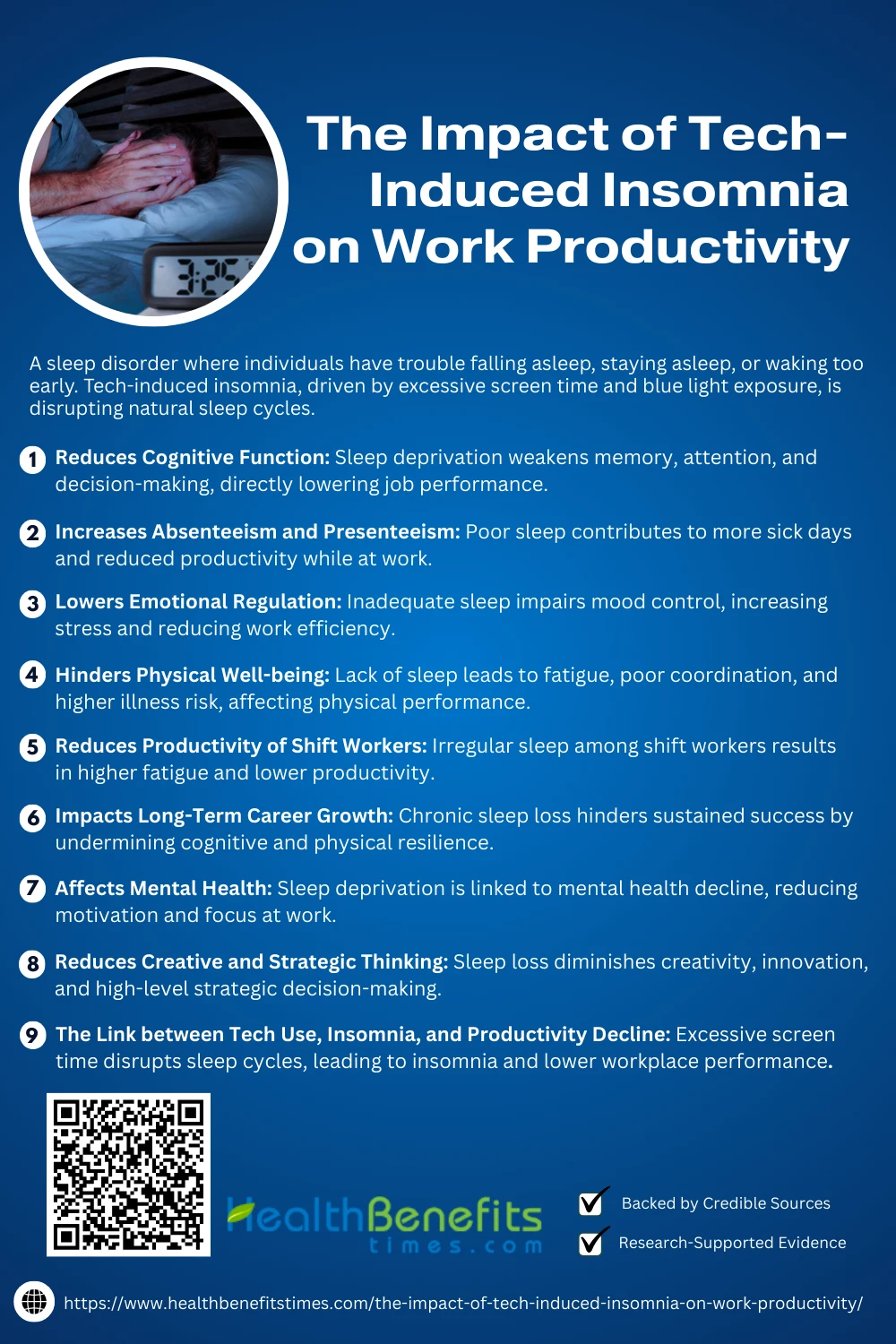- A sleep disorder where individuals have trouble falling asleep, staying asleep, or waking too early.
- Tech-induced insomnia, driven by excessive screen time and blue light exposure, is disrupting natural sleep cycles.
- This disruption leads to reduced focus, lower productivity, and increased workplace burnout.
 Insomnia is a common sleep disorder characterized by difficulty falling asleep, staying asleep, or waking too early and not being able to return to sleep, often leading to impaired daytime functioning. In our hyper-connected digital era, the rise of tech-induced insomnia—sleep disruption caused by excessive use of devices like smartphones, laptops, and tablets—has emerged as a significant concern for both individuals and organizations. Prolonged exposure to screen light, especially blue light, interferes with melatonin secretion and circadian rhythms, contributing to chronic sleep deprivation. Studies have shown a clear link between insomnia and deteriorating job performance, with employees experiencing increased fatigue, reduced cognitive sharpness, and higher error rates. For example, a comprehensive analysis by Mazzonna et al. (2025) reveals that poor sleep health driven by low-value care practices, including overreliance on tech, negatively affects economic productivity across sectors (IZA Institute of Labor Economics). Similarly, research by Briggs et al. (2025) highlights that insomnia significantly impacts work performance, influencing metrics such as absenteeism, presenteeism, and workplace engagement. Moreover, findings from Rodrigues et al. (2025) discuss how stress and tech-driven sleep disorders disrupt workplace mental well-being, ultimately reducing output and increasing burnout among employees.
Insomnia is a common sleep disorder characterized by difficulty falling asleep, staying asleep, or waking too early and not being able to return to sleep, often leading to impaired daytime functioning. In our hyper-connected digital era, the rise of tech-induced insomnia—sleep disruption caused by excessive use of devices like smartphones, laptops, and tablets—has emerged as a significant concern for both individuals and organizations. Prolonged exposure to screen light, especially blue light, interferes with melatonin secretion and circadian rhythms, contributing to chronic sleep deprivation. Studies have shown a clear link between insomnia and deteriorating job performance, with employees experiencing increased fatigue, reduced cognitive sharpness, and higher error rates. For example, a comprehensive analysis by Mazzonna et al. (2025) reveals that poor sleep health driven by low-value care practices, including overreliance on tech, negatively affects economic productivity across sectors (IZA Institute of Labor Economics). Similarly, research by Briggs et al. (2025) highlights that insomnia significantly impacts work performance, influencing metrics such as absenteeism, presenteeism, and workplace engagement. Moreover, findings from Rodrigues et al. (2025) discuss how stress and tech-driven sleep disorders disrupt workplace mental well-being, ultimately reducing output and increasing burnout among employees.
Understanding Tech-Induced Insomnia
Tech-induced insomnia refers to sleep disturbances resulting from excessive use of digital devices, especially before bedtime. It is primarily caused by overexposure to blue light emitted from screens, overstimulation from online content, and delayed sleep schedules. As George (2024) outlines in his study, modern sleep disorders have evolved with technology use, disrupting natural sleep cycles and habits (Partners Universal Multidisciplinary Research Journal). Kardaras (2022) further explores how digital overexposure creates an environment ripe for addictive sleep-disruptive behaviors (Digital Madness Book).
Common symptoms of tech-induced insomnia include difficulty falling or staying asleep, frequent nighttime awakenings, early morning waking, and fatigue during the day. Studies also report reduced mental alertness, mood disturbances, and irritability as prevalent among tech-overloaded individuals. According to Hanif et al. (2025), chronic use of devices not only alters circadian cues but also leads to measurable declines in both cognitive and behavioral sleep quality. (1) These symptoms, directly correlate with decreased work efficiency and emotional exhaustion. (2)
Biologically, tech-induced insomnia is linked to the suppression of melatonin, a hormone responsible for regulating sleep-wake cycles. Blue light interferes with the suprachiasmatic nucleus in the hypothalamus, disrupting the circadian rhythm. As explained by Venegas and Rosenberg (2025), such disruptions affect the glymphatic system’s ability to cleanse neurotoxins, resulting in cognitive fatigue and poor alertness. (3) Additionally, Nwaogu et al. (2025) emphasize that sleep deprivation impairs prefrontal cortex functions critical to decision-making and focus. (4)
How Sleep Affects Work Productivity
Quality sleep is essential for optimal work performance. It directly impacts your focus, memory, decision-making, and emotional stability—key factors that determine how productive and effective you are throughout the day.
Lack of sleep significantly impairs cognitive abilities essential for job performance, including attention, memory, and problem-solving. According to a systematic review by Jabade et al. (2025), sleep deprivation directly weakens executive functions. (5) Dongen (2025) highlights how fatigue compromises high-level reasoning tasks. (6) Research shows weakened decision-making during software development under sleep stress. (7) Xu (2025) found circadian disruption lowers peak alertness, while Sa’adah et al. (2025) tied fatigue to learning deficits. (8) (9)
2. Increases Absenteeism and Presenteeism
Inadequate sleep is a hidden driver of both absenteeism and presenteeism, reducing overall workplace efficiency. Daniels (2025) outlines how non-communicable diseases linked to poor sleep increase time off work. (10) Manu & Rysanek (2025) document reduced engagement among remote workers with sleep disturbances. (11) Alfeheid (2025) highlights presenteeism in fatigued workers. (12) Vallesi (2025) discusses how unresolved sleep debt affects performance longevity. (13) Nwaogu et al. (2025) tie poor sleep directly to job disengagement. (4)
3. Lowers Emotional Regulation
Lack of sleep significantly impairs emotional regulation, increasing stress, irritability, and mood instability, which diminishes workplace performance. Studies show emotional dysregulation and aggressive behavior are common among sleep-deprived individuals. (14) Chronic sleep loss leads to emotional exhaustion, reducing work efficiency, as confirmed by neurocognitive research. Additionally, EEG-based studies reveal cognitive-emotional disruptions linked to poor sleep. Ultimately, students’ psychological research highlights how sleep loss undermines emotional resilience, further impacting productivity.
4. Hinders Physical Well-being
Inadequate sleep compromises physical health and work output, manifesting as fatigue, reduced coordination, and illness susceptibility. Office workers’ health studies show sleep deprivation correlates with lower physical activity and motivation. (12) Sleep disturbances in healthcare environments heighten fatigue and errors. (15) Among patients, poor sleep quality worsens physical functioning. Psychological research affirms sleep’s role in sustaining physical readiness. (16) (17) Furthermore, breastfeeding studies reveal sleep loss contributes to burnout in working mothers, affecting performance. (18)
5. Reduces Productivity of Shift Workers
Sleep deprivation among shift workers significantly reduces their productivity and increases workplace errors. A study on night-shift nurses found reduced job satisfaction and increased fatigue. (19) Another report emphasized poor sleep affecting readiness and lifestyle. (20) Fatigue in shift workers compromises physical safety and cognitive alertness. Moreover, disrupted circadian rhythms lower work performance, and health data confirm chronic productivity loss in rotating shift roles. (21) (22) (23)
6. Impacts Long-Term Career Growth
Chronic sleep deprivation erodes long-term career progression by impairing productivity, cognitive resilience, and well-being. Research shows self-care, including sleep, is vital for sustained academic and career success. (24) Consistent rest enhances daily task efficiency. (25) Poor childhood sleep has lasting effects on adult performance. (26) Studies confirm lifestyle habits, including sleep, shape lifelong health and productivity. (27) Additionally, neurobiological links connect sleep quality with cognitive decline, affecting professional growth. (28)
7. Affects Mental Health
Sleep deficiency is strongly linked to mental health deterioration and diminished work productivity. Studies reveal poor sleep elevates depressive symptoms and reduces resilience at work. (29) In healthcare, sleep disruptions decrease vitality. (30) Among students, sleep deprivation amplifies psychological stress. (31) Research also shows that sleep loss impairs mood and cognition, leading to career burnout. (32) Lastly, workplace environments with shift-related sleep issues see heightened mental fatigue, reducing employee output. (33)
8. Reduces Creative and Strategic Thinking
Inadequate sleep impairs creative capacity and decision-making, key traits for effective workplace strategy. Sleep-deprived individuals show lower divergent thinking, crucial for innovation. (34) Entrepreneurs with sleep issues perform poorly in risk-based tasks. (35) Supervisory stress coupled with poor sleep reduces employee creativity. (36) REM sleep is essential for cognitive flexibility. (37) Lastly, research confirms sleep loss affects decision-making and productivity across multiple professions. (38)
The Link between Tech Use, Insomnia, and Productivity Decline
The growing prevalence of digital device use before bedtime is contributing to widespread insomnia and lowered productivity. Exposure to screens disrupts melatonin production, leading to sleep disturbances and cognitive fatigue. ({% trusted %}) Among workers, tech-related anxiety correlates with automation-induced insomnia and reduced job performance. Excessive screen time also conditions the brain for instant gratification, diminishing sustained focus. Over time, this pattern erodes sleep hygiene and workplace efficiency, posing challenges for both employees and employers. ({% trusted %})
Consequences for Organizations
Tech-induced insomnia doesn’t just affect individuals—it significantly impacts organizations. Reduced employee productivity, increased absenteeism, poor engagement, and rising healthcare costs are just a few consequences companies face due to widespread sleep deprivation.
 1. Reduced Employee Productivity
1. Reduced Employee Productivity
Tech-induced insomnia impairs cognitive functioning and leads to significant declines in employee productivity. Research indicates sleep-deprived staff underperform due to poor concentration and decision fatigue. (39) Constant tech exposure also causes attention loss and workplace inefficiency. (40) Additionally, time mismanagement from digital distractions compounds task delays. Organizations increasingly face challenges when insomnia-related symptoms, such as mental fog and fatigue, undermine daily operational effectiveness.
2. Higher Burnout and Turnover Rates
Tech-induced insomnia leads to chronic exhaustion, triggering emotional burnout and high employee turnover. Studies show that prolonged screen exposure disrupts natural sleep rhythms, causing stress and disengagement. (39) As energy reserves deplete, employees lose motivation and withdraw from organizational involvement. (41) This continuous sleep deficit results in workplace dissatisfaction and turnover intentions. Ultimately, businesses suffer from reduced retention as digital fatigue diminishes long-term loyalty.
3. Impaired Decision-Making and Innovation
Tech-induced insomnia severely impacts decision-making and innovation within organizations. Sleep deprivation hinders executive function and cognitive clarity, leading to flawed judgments. (39) Studies also show reduced strategic thinking and creativity in sleep-deprived professionals. When tech distractions dominate, employees suffer innovation fatigue. This erosion in cognitive resilience ultimately diminishes an organization’s capacity to adapt and remain competitive. (40)
4. Increased Health-Related Absenteeism
Tech-induced insomnia contributes to higher rates of absenteeism by exacerbating health problems such as fatigue, headaches, and weakened immunity. Prolonged screen exposure disrupts sleep cycles, increasing the risk of chronic conditions. (41) Research links poor sleep hygiene to frequent sick leaves. (40) Furthermore, mental and physical exhaustion caused by insomnia heightens vulnerability to illness. Organizations ultimately lose valuable work hours and efficiency due to preventable tech-related health impacts.
5. Decreased Workplace Morale
Tech-induced insomnia gradually erodes workplace morale by amplifying stress, fatigue, and social disengagement. Employees suffering from sleep loss often feel less motivated and connected to their teams. (40) Prolonged digital overstimulation contributes to emotional exhaustion, lowering interpersonal satisfaction at work. This decline in energy affects team cohesion and trust. Studies confirm that persistent insomnia symptoms weaken an organization’s morale and employee engagement metrics. (39)
6. Escalated Operational Costs
Organizations incur escalated operational costs as a direct result of tech-induced insomnia. Sleep-deprived employees make more errors, increasing rework and quality control expenses. (39) Health-related absences linked to insomnia strain insurance and medical cost burdens. (41) Additionally, digital fatigue undermines training ROI and workforce continuity, forcing employers to invest more in retention. The rise of tech-driven burnout further leads to productivity slumps and cost inefficiencies.
7. Threats to Organizational Culture
Tech-induced insomnia undermines organizational culture by weakening communication, collaboration, and trust. When employees experience chronic fatigue, their interpersonal engagement declines, harming team dynamics. (39) Sleep-deprived staff often withdraw socially, leading to fractured workplace relationships. Over time, this disrupts the collective values that sustain corporate identity. Research confirms that persistent sleep disruption weakens morale and dilutes cultural cohesion, eroding long-term organizational integrity. (40)
How to Combat Tech-Induced Insomnia
Combating tech-induced insomnia requires conscious lifestyle changes. From limiting screen time before bed to promoting healthier digital habits, both individuals and organizations can take steps to restore sleep quality and boost productivity.
 1. Limit Screen Time before Bed
1. Limit Screen Time before Bed
Reducing screen time before bed is one of the most effective ways to counter tech-induced insomnia. Studies show that digital overstimulation disrupts melatonin production, impairing sleep quality. (39) Experts emphasize that tech overuse before bed triggers mental hyperactivity, delaying sleep onset. Additionally, digital addiction is linked to chronic restlessness. Avoiding screens at least an hour before sleep improves circadian rhythm and reduces nighttime awakenings. (41)
2. Use Blue Light Filters
Using blue light filters on devices is a practical and proven solution to reduce tech-induced insomnia. Blue light suppresses melatonin, disrupting sleep cycles, but filtered devices show reduced circadian interference. (39) Studies highlight that screen filters mitigate tech-related sleep delays. Filtered light also lowers eye strain and enhances readiness for rest, as shown in digital wellness literature. Consistent use improves nighttime cognitive recovery and mood. (41)
3. Create a Device-Free Sleep Zone
Creating a device-free sleep zone is essential for restoring natural sleep cycles disrupted by constant digital exposure. Studies show that removing screens from bedrooms reduces mental stimulation and enhances melatonin flow. (39) Experts warn that even passive device presence interferes with sleep onset. Designating your bedroom as a tech-free zone promotes healthier sleep hygiene and helps prevent tech-induced restlessness. (41)
4. Practice Digital Detoxing
Digital detoxing is a powerful method for resetting sleep patterns affected by overuse of technology. Research shows that intentional breaks from digital platforms improve sleep quality and reduce anxiety. Weekend detox routines help reduce cognitive overstimulation and allow natural circadian rhythms to realign. Experts recommend structured time-outs from screens to restore emotional regulation and prevent insomnia relapse due to tech exposure. (42) (39)
5. Adopt Mindfulness and Breathing Exercises
Mindfulness and breathing exercises are proven techniques for reducing the anxiety and mental clutter caused by excessive tech exposure. Research shows that mindfulness significantly improves sleep latency and quality. Breathing techniques help shift the nervous system into a relaxed parasympathetic state. These methods reduce tech-related overthinking and promote emotional regulation, making them ideal for combating digital insomnia symptoms. (42) (39)
6. Set Consistent Sleep-Wake Cycles
Establishing a regular sleep-wake schedule strengthens circadian rhythms and mitigates the disruptive impact of screen time. Irregular sleep patterns, especially from tech overuse, interfere with the brain’s melatonin signals. (39) Experts advocate for fixed wake and sleep times to retrain internal clocks. Consistency improves REM stability and sleep efficiency and protects against chronic sleep fragmentation common in digital lifestyles. (42)
7. Engage in Physical Activity during the Day
Daily physical activity enhances sleep depth and reduces the arousal caused by excessive screen use. Studies show that consistent exercise improves sleep onset and duration, especially in tech-heavy environments. (39) Movement regulates circadian rhythms, making individuals less prone to insomnia. Additionally, physical exertion reduces anxiety triggered by screen time and improves nighttime rest. (42) Even moderate daytime movement helps reverse tech-related fatigue.
8. Avoid Doomscrolling and Tech-Related Stress
Avoiding doomscrolling is crucial to easing tech-related insomnia, as constant exposure to negative content fuels anxiety and delays sleep onset. Research links doomscrolling to emotional dysregulation and hyperarousal. Limiting nighttime media consumption improves sleep hygiene and reduces racing thoughts. Experts advise establishing digital boundaries to control stress triggers, and evidence shows that screen content affects sleep quality more than screen time alone. (39) (42)
9. Promote work-life balance
Promoting work-life balance is essential in mitigating the effects of tech-induced insomnia. Constant digital connectivity fuels stress and blurs personal boundaries, disrupting rest patterns. (39) Balanced routines protect against mental burnout and tech fatigue. Encouraging downtime away from screens helps realign biological sleep rhythms. (42) Ultimately, healthier scheduling and boundaries lead to improved cognitive recovery and sleep quality, strengthening productivity and well-being.
Conclusion
The Impact of Tech-Induced Insomnia on Work Productivity
Tech-induced insomnia is a growing concern in our always-connected world, significantly affecting individual well-being and organizational productivity. As technology continues to blur the line between work and rest, sleep quality suffers—leading to cognitive decline, emotional instability, and reduced workplace performance. However, by recognizing the causes and consequences of tech-related sleep disruptions, both individuals and organizations can take proactive steps to mitigate the impact. Encouraging healthy digital habits, promoting work-life balance, and prioritizing sleep as a critical component of productivity can make a meaningful difference. Ultimately, better sleep leads to sharper minds, healthier employees, and a more efficient, successful workplace.



